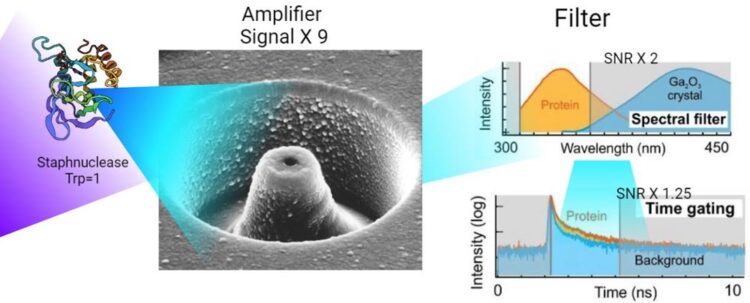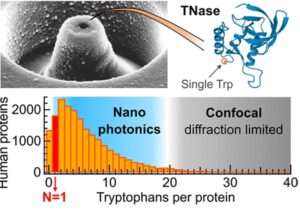Ultraviolet nanophotonics enable autofluorescence correlation spectroscopy

Advance Nano-structures to amplify signal from single-tryptophan proteins and technique to enhance the signal to Noise ratio.
Credit: CNRS, Intitut Fresnel, Aix Marseilles University
… on label-free proteins with a single tryptophan.
Proteins are naturally fluorescent in the ultraviolet, offering an appealing approach to probe proteins in their native state without introducing any external fluorescent label. The UV autofluorescence of proteins is based on the presence of tryptophan amino acids, which typically occur as 1 to 5 tryptophan per protein. However, due to weak signals and large backgrounds in the UV, the current technology was restricted to large proteins featuring several tens of tryptophan residues. The vast majority of proteins remained well below the detection sensitivity for single label-free protein detection.

Credit: CNRS, Intitut Fresnel, Aix Marseilles University
Ina recent Nano Letters publication, our team breaks into this sensitivity limit and achieves label-free UV-autofluorescence detection down to the single tryptophan level thanks to a nanophotonic enhancement of the signal. Our approach relies on a rationally-designed combination of plasmonic antennas, antioxidants and background noise reduction techniques to improve the signal to background ratio by over an order of magnitude. Achieving the ultimate sensitivity of UV-FCS down to the single tryptophan regime has wide applications for various communities from nanophotonics to biochemistry.
We conclusively demonstrate UV-fluorescence correlation spectroscopy (UV-FCS) on proteins with a single tryptophan residue. This unlocks the applicability of UV-FCS to a broad library of thousands of proteins, which remained previously inaccessible (over 90% of human proteins have at least one tryptophan residue, but only 4% have more than 20 tryptophans). Fluorescence correlation spectroscopy (FCS) and related techniques have a large impact on molecular biophysics in assessing diffusion properties, local concentrations or kinetic reaction rates.
The signal to background maximization approach is of interest to a wide range of scientists and engineers working with single molecule fluorescence, photonics, or plasmonics. Our article details several multidisciplinary aspects: (i) plasmonic nanophotonic elements to enhance the fluorescence, (ii) antioxidants to neutralize the reactive oxygen species ubiquitous to ultraviolet and (iii) background suppression based on a rational understanding of the background physical origins.
For further reading refer:
“Ultraviolet Nanophotonics Enables Autofluorescence Correlation Spectroscopy on Label-Free Proteins with a Single Tryptophan”
https://pubs.acs.org/doi/10.1021/acs.nanolett.2c03797
Contact:
Prithu Roy
Ph.D
CNRS, Intitut Fresnel, Aix Marseilles University
Media Contact
All latest news from the category: Life Sciences and Chemistry
Articles and reports from the Life Sciences and chemistry area deal with applied and basic research into modern biology, chemistry and human medicine.
Valuable information can be found on a range of life sciences fields including bacteriology, biochemistry, bionics, bioinformatics, biophysics, biotechnology, genetics, geobotany, human biology, marine biology, microbiology, molecular biology, cellular biology, zoology, bioinorganic chemistry, microchemistry and environmental chemistry.
Newest articles

New SPECT/CT technique shows impressive biomarker identification
…offers increased access for prostate cancer patients. A novel SPECT/CT acquisition method can accurately detect radiopharmaceutical biodistribution in a convenient manner for prostate cancer patients, opening the door for more…

How 3D printers can give robots a soft touch
Soft skin coverings and touch sensors have emerged as a promising feature for robots that are both safer and more intuitive for human interaction, but they are expensive and difficult…

Oxygen vacancies mediated ultrathin Bi4O5Br2 nanosheets
… as efficient piezocatalyst for synthesis of H2O2 from pure water. As an important chemical raw material, hydrogen peroxide (H2O2) is widely applied in various aspects of industry and life….





















